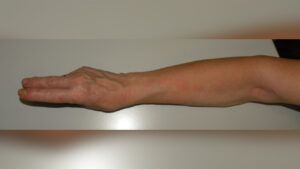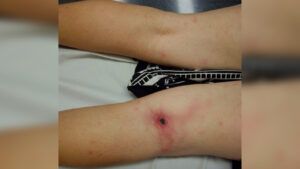Lymphangitis is an infection and inflammation of the lymph vessels. It can result from a bacterial skin infection. A person may notice red or dark streaks extending from the site of an injury, along with swelling, pain, and warmth.
The lymphatic system features lymph vessels, similar to blood vessels, that carry lymphatic fluid throughout the body.
If an infection occurs, lymphatic fluid carries lymphocytes — a type of white blood cell — to the infection site to help fight the infection. If the lymph vessels become infected, lymphangitis can result.
A person with lymphangitis may notice streaks on the skin. If the infection is in the hand, for example, the streaks may spread up the arm.
Treatment for lymphangitis will depend on the cause. It typically results from a bacterial infection, and the treatment is usually with antibiotics.




People with lymphangitis may notice streaks extending from the site of an injury to areas with a lot of lymph glands, such as the armpits or groin.
The streaks may:
- appear red or darker than the surrounding skin
- be irregular in shape
- feel warm
- be tender or painful
- spread from an infection site toward the lymph nodes, for example, up the arms toward the underarm
Other symptoms of lymphangitis may include:
Blood tests may show a high white blood count, known as leukocytosis.
Symptoms of sepsis
Without treatment, the infection can spread to other body parts, leading to sepsis. Sepsis is a life threatening condition that can cause a high fever, flu-like symptoms, and even organ failure.
People with the following symptoms
- a rapid heart rate or weak pulse
- confusion
- severe pain
- breathing problems
- fever or chills
- clammy skin or sweating
A person who feels very ill following an injury or has a high fever and symptoms of lymphangitis should seek emergency medical attention.
Lymphangitis is a secondary infection, meaning it happens because of another infection. If an infection travels from the original site to the lymph vessels, the vessels become inflamed and infected.
Bacterial infections are the most common cause of lymphangitis, but viral and fungal infections can also cause it.
Any injury that allows a virus, bacteria, or fungus to enter the body can cause an infection that leads to lymphangitis. Possible causes include:
- puncture wounds, such as from stepping on a nail or other sharp object
- untreated or severe skin infections,
such asTrusted Source cellulitis - insect bites and stings
- a wound that needs stitches
- infected surgical wounds
- sporotrichosis, a fungal skin infection that
often affectsTrusted Source gardeners
People with a history of lymphedema, which causes swelling in the body’s tissues, may have a higher risk of lymphangitis.
A doctor may suspect lymphangitis from a person’s symptoms. If a person has swollen lymph nodes, red streaks extending from an injury, or other signs of infection, a doctor may begin treatment with antibiotics, even before test results are ready.
This will enable treatment to start as soon as possible.
Tests, including blood tests, may help identify the cause of the infection so that the doctor can target the infection effectively. It will also enable them to provide treatment for any underlying problem.
When the test results are ready, a doctor may change the treatment or add further medication to the person’s treatment plan.
In some cases, a doctor might do a biopsy of any swollen lymph nodes to rule out other conditions.
Most cases of lymphangitis will need antibiotics that are effective against staph and strep, such as dicloxacillin (Diclocil), as treatment. For a fungal or viral infection, a doctor will prescribe antifungal or antiviral medications.
If the infection persists after one course of treatment, the doctor may recommend another course. Rarely, an individual may need surgery to remove infected tissue.
Lymphangitis can be very painful. To help with the pain, a person can try:
- applying warm compresses to the injury and areas with red streaks
- using anti-inflammatory medications, such as ibuprofen (Advil)
- taking prescription-strength pain relievers from a doctor
Treatment aims to stop the infection from spreading. To assess whether treatment is working, a doctor may outline streaks with a marker or take pictures to see whether they contract or continue to spread following treatment.
If more streaks appear, a wound seems to get worse, or a person develops additional symptoms, it may be a sign that their treatment plan needs adjustment.
The time it takes to recover from lymphangitis may depend on the severity of the infection and the individual’s health status.
Factors that may lengthen the recovery time include:
- having a weakened immune system
- older age
- developing complications, such as sepsis
A person who has surgery to remove damaged tissue may need physical therapy after. However, many people can return to their daily lives after a lymphangitis infection heals.
Some people
For example, if lymphangitis develops from athlete’s foot, it may return if the athlete’s foot does not respond to treatment.
People with weakened immune systems also have a higher risk of recurrent lymphangitis because it is harder for their bodies to fight off infections.
What can doctors mistake for lymphangitis?
Doctors may need to rule out conditions such as superficial thrombophlebitis, phytophotodermatitis, and drug-induced pigmentation when diagnosing lymphangitis.
Is lymphangitis contagious?
Lymphangitis itself is not contagious. However, it can occur due to bacterial, viral, and fungal infections or parasites, which a person
Is lymphangitis an emergency?
Lymphangitis can spread quickly and lead to severe complications, so a person should seek medical help as soon as possible. Some people may need to spend time in the hospital.
Lymphangitis is an infection and inflammation of the lymph vessels. It usually spreads to the lymphatic system from a primary infection. The infection is usually bacterial but can be fungal or viral.
It can cause streaks of discoloration toward lymph nodes and may lead to other symptoms, such as fever, chills, and headache.
Anyone with signs of lymphangitis should seek treatment at once. In some cases, not treating the infection can lead to severe complications, such as sepsis.


